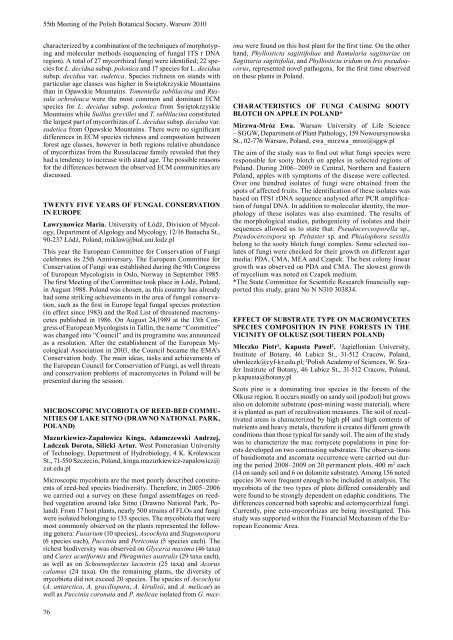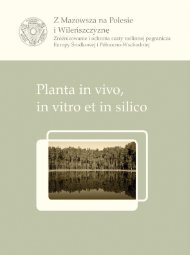acta societatis botanicorum poloniae - LV Zjazd Polskiego ...
acta societatis botanicorum poloniae - LV Zjazd Polskiego ...
acta societatis botanicorum poloniae - LV Zjazd Polskiego ...
Create successful ePaper yourself
Turn your PDF publications into a flip-book with our unique Google optimized e-Paper software.
55th Meeting of the Polish Botanical Society, Warsaw 2010<br />
characterized by a combination of the techniques of morphotyping<br />
and molecular methods (sequencing of fungal ITS r DNA<br />
region). A total of 27 mycorrhizal fungi were identified; 22 species<br />
for L. decidua subsp. polonica and 17 species for L. decidua<br />
subsp. decidua var. sudetica. Species richness on stands with<br />
particular age classes was higher in Świętokrzyskie Mountains<br />
than in Opawskie Mountains. Tomentella sublilacina and Russula<br />
ochroleuca were the most common and dominant ECM<br />
species for L. decidua subsp. polonica from Świętokrzyskie<br />
Mountains while Suillus grevillei and T. sublilacina constituted<br />
the largest part of mycorrhizas of L. decidua subsp. decidua var.<br />
sudetica from Opawskie Mountains. There were no significant<br />
differences in ECM species richness and composition between<br />
forest age classes, however in both regions relative abundance<br />
of mycorrhizas from the Russulaceae family revealed that they<br />
had a tendency to increase with stand age. The possible reasons<br />
for the differences between the observed ECM communities are<br />
discussed.<br />
TWENTY FIVE YEArS OF FUNGAL CONSErVATION<br />
IN EUrOPE<br />
Ławrynowicz Maria. University of Łódź, Division of Mycology,<br />
Department of Algology and Mycology, 12/16 Banacha St.,<br />
90-237 Łódź, Poland, miklaw@biol.uni.lodz.pl<br />
This year the European Committee for Conservation of Fungi<br />
celebrates its 25th Anniversary. The European Committee for<br />
Conservation of Fungi was established during the 9th Congress<br />
of European Mycologists in Oslo, Norway in September 1985.<br />
The first Meeting of the Committee took place in Łódź, Poland,<br />
in August 1988. Poland was chosen, as this country has already<br />
had some striking achievements in the area of fungal conservation,<br />
such as the first in Europe legal fungal species protection<br />
(in effect since 1983) and the Red List of threatened macromycetes<br />
published in 1986. On August 24,1989 at the 13th Congress<br />
of European Mycologists in Tallin, the name “Committee”<br />
was changed into “Council” and its programme was announced<br />
as a resolution. After the establishment of the European Mycological<br />
Association in 2003, the Council became the EMA’s<br />
Conservation body. The main ideas, tasks and achievements of<br />
the European Council for Conservation of Fungi, as well threats<br />
and conservation problems of macromycetes in Poland will be<br />
presented during the session.<br />
MICrOSCOPIC MYCOBIOTA OF rEEd-BEd COMMU-<br />
NITIES OF LAKE SITNO (drAWNO NATIONAL PArK,<br />
POLANd)<br />
Mazurkiewicz-Zapałowicz Kinga, Adamczewski Andrzej,<br />
Ładczuk Dorota, Silicki Artur. West Pomeranian University<br />
of Technology, Department of Hydrobiology, 4 K. Królewicza<br />
St., 71-550 Szczecin, Poland, kinga.mazurkiewicz-zapalowicz@<br />
zut.edu.pl<br />
Microscopic mycobiota are the most poorly described constituents<br />
of reed-bed species biodiversity. Therefore, in 2005– 2006<br />
we carried out a survey on these fungal assemblages on reedbed<br />
vegetation around lake Sitno (Drawno National Park, Poland).<br />
From 17 host plants, nearly 500 strains of FLOs and fungi<br />
were isolated belonging to 133 species. The mycobiota that were<br />
most commonly observed on the plants represented the following<br />
genera: Fusarium (10 species), Ascochyta and Stagonospora<br />
(6 species each), Puccinia and Periconia (5 species each). The<br />
richest biodiversity was observed on Glyceria maxima (46 taxa)<br />
and Carex acutiformis and Phragmites australis (29 taxa each),<br />
as well as on Schoenoplectus lacustris (25 taxa) and Acorus<br />
calamus (24 taxa). On the remaining plants, the diversity of<br />
mycobiota did not exceed 20 species. The species of Ascochyta<br />
(A. antarctica, A. gracilispora, A. kirulisii, and A. melicae) as<br />
well as Puccinia coronata and P. melicae isolated from G. max-<br />
76<br />
ima were found on this host plant for the first time. On the other<br />
hand, Phyllosticta sagittifoliae and Ramularia sagittariae on<br />
Sagittaria sagittifolia, and Phyllosticta iridum on Iris pseudoacorus,<br />
represented novel pathogens, for the first time observed<br />
on these plants in Poland.<br />
CHArACTErISTICS OF FUNGI CAUSING SOOTY<br />
BLOTCH ON APPLE IN POLANd*<br />
Mirzwa-Mróz Ewa. Warsaw University of Life Science<br />
– SGGW, Department of Plant Pathology, 159 Nowoursynowska<br />
St., 02-776 Warsaw, Poland, ewa_mirzwa_mroz@sggw.pl<br />
The aim of the study was to find out what fungi species were<br />
responsible for sooty blotch on apples in selected regions of<br />
Poland. During 2006– 2009 in Central, Northern and Eastern<br />
Poland, apples with symptoms of the disease were collected.<br />
Over one hundred isolates of fungi were obtained from the<br />
spots of affected fruits. The identification of these isolates was<br />
based on ITS1 rDNA sequence analysed after PCR amplification<br />
of fungal DNA. In addition to molecular identity, the morphology<br />
of these isolates was also examined. The results of<br />
the morphological studies, pathogenicity of isolates and their<br />
sequences allowed us to state that: Pseudocercosporella sp.,<br />
Pseudocercospora sp. Peltaster sp. and Phialophora sessilis<br />
belong to the sooty blotch fungi complex. Some selected isolates<br />
of fungi were checked for their growth on different agar<br />
media: PDA, CMA, MEA and Czapek. The best colony linear<br />
growth was observed on PDA and CMA. The slowest growth<br />
of mycelium was noted on Czapek medium.<br />
*The State Committee for Scientific Research financially supported<br />
this study, grant No N N310 303834.<br />
EFFECT OF SUBSTrATE TYPE ON MACrOMYCETES<br />
SPECIES COMPOSITION IN PINE FOrESTS IN THE<br />
VICINITY OF OLKUSZ (SOUTHErN POLANd)<br />
Mleczko Piotr 1 , Kapusta Paweł 2 . 1 Jagiellonian University,<br />
Institute of Botany, 46 Lubicz St., 31-512 Cracow, Poland,<br />
ubmleczk@cyf-kr.edu.pl; 2 Polish Academy of Sciences, W. Szafer<br />
Institute of Botany, 46 Lubicz St., 31-512 Cracow, Poland,<br />
p.kapusta@botany.pl<br />
Scots pine is a dominating tree species in the forests of the<br />
Olkusz region. It occurs mostly on sandy soil (podzol) but grows<br />
also on dolomite substrate (post-mining waste material), where<br />
it is planted as part of recultivation measures. The soil of recultivated<br />
areas is characterized by high pH and high contents of<br />
nutrients and heavy metals, therefore it creates different growth<br />
conditions than those typical for sandy soil. The aim of the study<br />
was to characterize the mac romycete populations in pine forests<br />
developed on two contrasting substrates. The observa-tions<br />
of basidiomata and ascomata occurrence were carried out during<br />
the period 2008– 2009 on 20 permanent plots, 400 m 2 each<br />
(14 on sandy soil and 6 on dolomite substrate). Among 156 noted<br />
species 36 were frequent enough to be included in analysis. The<br />
mycobiota of the two types of plots differed considerably and<br />
were found to be strongly dependent on edaphic conditions. The<br />
differences concerned both saprobic and ectomycorrhizal fungi.<br />
Currently, pine ecto-mycorrhizas are being investigated. This<br />
study was supported within the Financial Mechanism of the European<br />
Economic Area.



